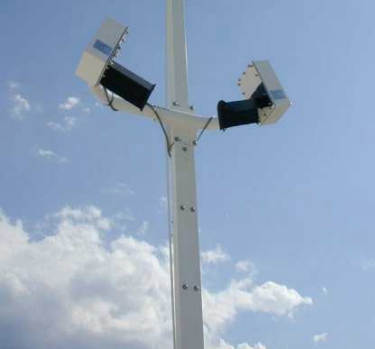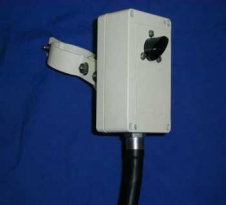
download the leaflet: Runway Visual Range RVR-6000
No. RVR-6000 - Runway Visual Range
- meets or exceeds ICAO recommendations, WMO requirements
- continues Belfort’s reputatation for supierior visibility sensors
- specifically manufactured for RVR applications
- latest forward scatter sensor technology
- compatable with CAT I, II, or IIIB airports
The Belfort RVR system consists of:
the model 6000 visibility sensor
known worldwide as a standard in visibility measurement
the ambient light sensor (ALS)
the runway light interface (RWIS)
the proprietary RVR software program
The RVR system measures the transparency of the atmosphere and calculates an extension coefficient taking in to affect the ambient light conditions. When the runway light intensity is integrated into the RVR algorithm, runway visual range values are determined.
The Belfort forward scatter visibility sensor provides accurate measurements in all weather conditions, including fog, smoke, heavy precipitation and snow. Adding the high performance of the Model 6000 visibility sensor with the proven RVR algorithms insure the most accurate runway visual range values are reported to the users.
The Model 6000 visibility sensors, used in the RVR system, have been calibrated through a specific chain of standards traceable to a reference “transmissometer”. Using this calibration standard ensures that the runway visual range measurements and calculations meet aviation quality standards
Specifications
Performance
Measurement range (MOR): 6 m to 80 km (20 ft to 50 miles)
Accuracy: +/- 10% or 3m (10 feet)
Output Intervals: 10 Sec or 1, 5, 10 minutes
Averaging Intervals: 3, 5 or 10 minutes
Measurement: Meteorological Optical Range (MOR) or Extinction coefficient
Units: kilometers or miles
Baud Rate: Variable
Principle of Operation
Visibility Sensor: Forward Scatter
Light Source: Infrared LED
Scatter Angle: 42°
Communications: RS232, RS485, 300-38, 400 Baud
Ambien Light Sensor (detailed information below)
Field of view: 6°
Range: 2 to 40,000 candelas/m2
Runway Light Interface
Hardware: RS232 Relay
Edge Light: CAT I, CAT II, and CAT IIIa installations
Centerline Lights: CAT IIIb installations
Control: RVR Software Control
RVR
Output Intervals: 10 -120 seconds
Averaging Intervals: 1, 2, and 10 minutes
Trend: 1, 2, and 10 minutes
Algorithms:
Daytime: Koschmieder’s Law
Nighttime: Allard’s Law
Reporting Range: Output per FAA FMH-1 and ICAO Annex 3
Meters: 0-2000
Feet: 0-6000
Environmental
Operating: -40 °C to + 55 °C (-400 to +1300F)
Approval: CE Approved .
download the leaflet: Visibility Ambient Light Sensor No. 6300
No. 6300 - Visibility Ambient Light Sensor
- Compact, Modular design
- Extensive self-diagnostics
- Proven field qualified enclosure
- National Weather Service, CE approved
- Serial and analog outputs
- Built-in self test, including window fouling
- RS232 and Analog outputs
- Window/hood heater prevents fogging
and snow accumulation
- Enclosure heater for low temperature operation
The Belfort Model 6300 Ambient Light Sensor is designed to integrate with any Belfort Visibility Sensor, providing accurate and reliable visibility and ambient light data for Runway Visual Range calculations. With both serial and analog outputs, the Model 6300 can also be used as a stand-alone ambient light sensor.
The physical package for the sensor is the same proven design already installed in over 1,000 ASOS Visibility Sensor suites worldwide. Both window/hood and electronic heaters are employed for low temperature and blowing precipitation conditions.
Extensive self-diagnostics include processor, memory and heater diagnostics as well as window fouling conditions.
These sensors are assembled around a compact and sturdy corrosion resistant housing which can be easily installed on the Visibility Sensor support mast. The standard unit incorporates optics/hood heaters to prevent condensation on the optic elements and to prevent freezing precipitation on the hood. A thermostatically operated enclosure heater may also be separately powered for extremely low temperature operation.
Belfort Visibility Sensors have earned a eading reputation with the world'sbforemos meteorological and transportation organizations. The Model 6300 Ambient Light Sensor brings the same high reliability technology to Runway Visual Range applications.
Specifications:
Range: 0.5 to 10,000 fL
Field of View: 6.0°C
Outputs
Analog: 0-1, 0-5 or 0-10V,
Serial: 300-19200 baud
Heater power: 11W @ 24VDC
Dimensions: 5" x 3" x 2-1/4"
Weight: 2.5 lbs
Operating Temp.: -55° to +60°C
Humidity: 0 to 100% RH
Power Requirements: 1W @ 12VD
Mounting: Mast clamp
Dr. Alfred Müller - Meteorologische Instrumente KG
Chausseestraße 39 / 42c, D-15712 Königs Wusterhausen
Telefon: +49 (0)3375 9025-32 Telefax.: +49 (0)3375 9025-36
e-Mail: dr.a.mueller-r.fuess@t-online.de